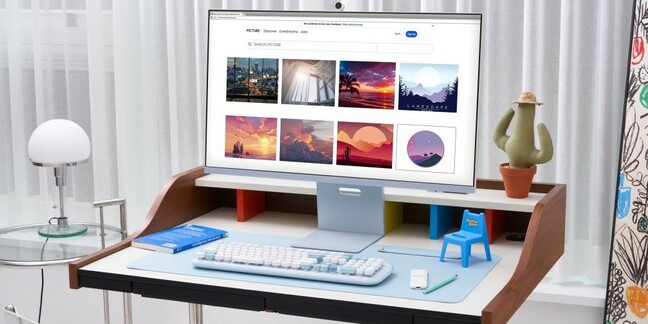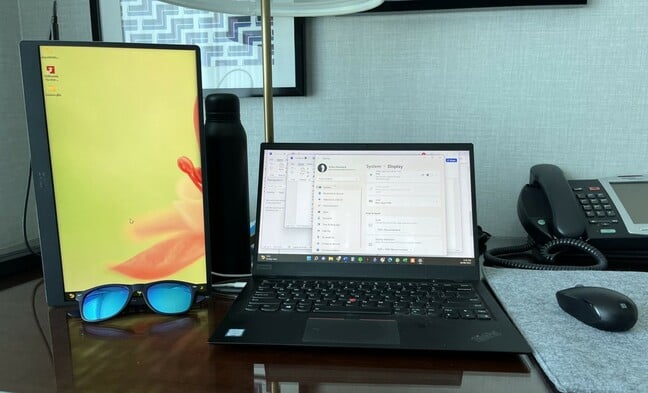This article is more than 1 year old
Samsung’s Smart Monitor tries too hard to be clever
Barely adequate as a desktop alternative, but delightful as a dual purpose monitor
Desktop Tourism Samsung's vision for a smart monitor tantalizes: the company suggests you park your PC and instead connect mouse and keyboard to a monitor that boasts a built in browser and Office 365. If you really need a PC, the device includes a client for remote access to a PC or Mac.
Once the working day is done, the 32 inch M8 Smart Monitor includes Samsung's smart TV interface and can run apps that allow it to connect to myriad streaming services.
The device mostly delivers as an entertainment machine. Samsung's Tizen-based Smart TV environment is intuitive, slick, and speedy. The M8's 3,840 x 2,160 display is large, bright, pleasant, and handles subtle color grading and rapidly changing images well.
Speakers are merely adequate, as you'd expect of a display that's just 22mm deep. Bluetooth speakers are therefore an option many will chose to add.
Some may miss the presence of a TV tuner, but I was able to find apps for local free-to-air stations and stream their offerings. Samsung's remote control is entirely adequate, and the inclusion of USB-C charging for the remote's battery is pleasing.
The M8 can therefore do a job as a TV alternative in a small room. I can imagine it would work very well in a teen's bedroom, for example, allowing them to watch vids from their beds instead of curling up with a laptop.
But that hypothetical teen could not use the M8 for much work. Nor could any other knowledge worker.
Samsung's promised integration of Office 365 is very much skin deep – you get links to web app versions of Microsoft's famous productivity suite and, if you have an account, access to cloud storage. Each Office app appears in a browser tab that immediately occupies the entire screen. Samsung's supplied browser reported it is incompatible with Teams, making the included webcam less useful.
It is possible to exit full screen and view the web apps as browser tabs, but the device never offers anything that resembles a desktop metaphor or PC-like user experience. It's hard, for example, to switch between apps.
Instead, as soon you leave a browser tab the device offers a UI designed for being driven by a remote control. Getting anything done requires a lot of poking about with a giant cursor, or reversion to the remote.
The device offers the chance to add other "Workspaces" so I did by signing into my Google account. Again the browser protested it was not built to handle the web apps on offer.
Remoting into a PC was easy, but performance was not crisp enough to be a viable option for more than a few minutes of work.
I can therefore image the M8 could be useful for emergency access to a document that has to be fixed before you get to work tomorrow, but the monitor is not going to work for remote work.
On the road with a portable monitor
In the last few weeks I've indulged in some actual tourism – a trip to the USA to catch up with colleagues and attend a conference – and took a Dell C1422H Portable Monitor along for the ride.
The device is a 14-inch LCD HD monitor with USB-C connectors. It weighs 590 grams and comes in a felt pouch. It's about the size of a laptop and fit in my messenger bag's padded PC slot, alongside my ThinkPad, without needing a shove or a squeeze.
I found the monitor a pleasant companion for the rare moments my trip required a couple of hours uninterrupted working.
Here it is on a hotel room desk, with its pouch serving as a mousepad.
I'm above average height and find a day spent working on a laptop puts me at risk of neck pain. The extra screen let me lean out just enough to be more physically comfortable, and once I figured out that the machine's stand is stable in portrait or landscape orientation I was able to put windows closer to my eyeline and appreciated that immensely.Dell's monitor sells for $320 – $9 less than Apple's most basic iPad – or $29 less than Samsung's cheapest Galaxy Tab S8. While both of those tablets are smaller than the portable monitor, they can extend a Mac's or a PC's screen … and probably be used on more days a year than the dedicated portable display.
If I were spending my own money, I'd probably buy the tablet. But for those of you who travel for work and are happy to make your bags a little bulkier, I recommend trying to get the boss to pay for this portable monitor in the name of improved ergonomics wherever you roam.
The M8 also annoyed in other ways. Writing Desktop Tourism means I've plugged a lot of computers into a lot of monitors this year: the M8 could not detect the presence of my workhorse ThinkPad using HDMI, the first such failure I've experienced.
The monitor boasts a pair of USB-C ports, but only one can handle video and the tiny glyphs that make that apparent are all-but-impossible to see because the ports are on the device's rear and are hidden by its stand. Yes, I could have read the manual, but the M8 is a monitor, a class of device I think it is reasonable to assume plugs and plays.
The USB-C cable that Samsung supplies with the monitor is of miserly length so it's hard to arrange a desktop around the M8. Whether that's a casualty of Samsung being a bit cheap, or the vagaries of USB-C cables, or both, is hard to divine. At least the cable can carry power to a laptop so the monitor can charge a PC. But the cable and monitor could not automatically detect a Mac I plugged in for some extra testing.
I also found it odd that the M8 doesn't turn off when a connected laptop is closed or shut down. The monitor instead displays a splash screen with a countdown to entering Smart TV mode, and that can only be dispelled by finding the remote and powering down the monitor.
Once I figured out the M8's foibles, which meant ignoring its role as a PC alternative, I enjoyed having it around. I found that a monitor which includes a Smart TV interface draws a pleasingly sharper line between work and play by removing my PC as a distraction while watching videos.
But by trying to be clever with the addition of Office 365, the whole package struggles to deliver on the promise of being Smart. A monitor with a Smart TV interface, and a crisp and definitive personality change to a dumb PC-driven display, would be more satisfying than this machine's poor attempt at adding productivity features. Samsung also needs to drop the price of this $700 device, because that sum can cover the cost of a decent monitor and a low end smart TV. ®


